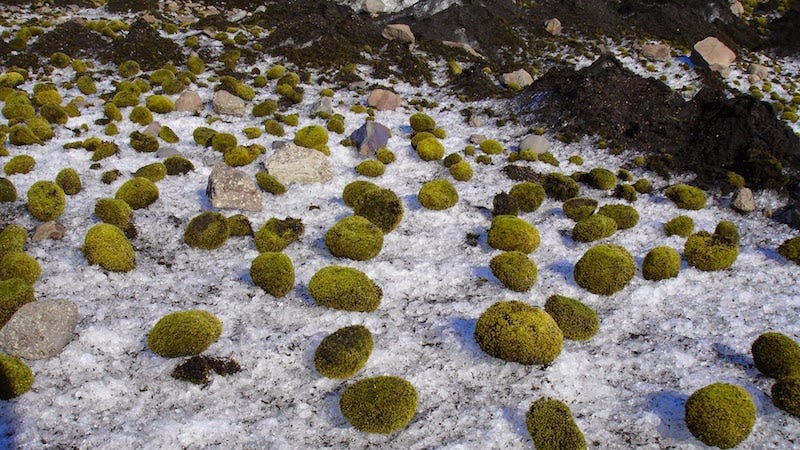
Say Hello to 'Glacier Mice', a Herd of Mysterious Moving Moss Balls
by Jody SerranoIn some places around the world, you can find bright green balls of moss scattered across glaciers. That picture is incredible all by itself, but what is truly mind-boggling is that this colony of moss balls moves. All at about the same speeds and in the same directions.
The glacier moss balls are commonly referred to as “glacier mice”, and were the subject of a recent study published online in Polar Biology this month. According to a report from NPR, each ball resembles a soft, wet and squishy pillow of moss. The study’s authors believe that they develop from impurities on ice surfaces and represent a relatively rare phenomenon.
One of the authors, Tim Bartholomaus, a glaciologist at the University of Idaho, told NPR that he remembered thinking “What the heck is this!” when he first stumbled upon the mice in 2006 around the Root Glacier in Alaska.
“They’re not attached to anything and they’re just resting there on ice,” Bartholomaus said. “They’re bright green in a world of white.”
They don’t stay at rest for long, though. Bartholomaus said that the glacier moss balls in the study moved about an inch (2.5 centimetres) per day on average. Sophie Gilbert, a wildlife ecologist at the University of Idaho and another one of the study’s coauthors, noted that movement is a necessity for the glacier moss balls because the entire surface of the ball must periodically get exposed to the sun.
“These things must actually roll around or else that moss on the bottom would die,” Gilbert said.
If you’re like me and also wanted to see these mice moving, you can check out a video of glacier mice from the Root Glacier below. The video is not related to the study but is still very cool to watch. It also shows glacier mice in some pretty funny (and inappropriate) positions. Make your own conclusions.
Glacier mice aren’t new and have been spotted in Alaska, Iceland, Svalbard and South America. Scientists have known about them since at least the 1950s. However, despite knowing that these mysterious glacier moss balls exist, scientists still have a lot to learn about them.
One of the biggest questions is why the mice, which can live for at least six years, move the way they do. Some scientists believed the key could be in ice pedestals, which could form because the ball protects the ice underneath it and prevents it from melting as fast as the surrounding ice. According to this theory, the ball would eventually fall off the ice pedestal and roll away.
To try to get to the bottom of this, the researchers decided to track 30 glacier moss balls in Alaska and tagged each ball with a small loop of wire with coloured beads. Per NPR, they tracked the location of each ball for 54 days in 2009 and then returned to check on them in 2010, 2011 and 2012. Although they expected that the balls would be in random places from rolling off ice pedestals, this was not the case.

The glacier moss balls moved together. Bartholomaus compared this to a herd of wildebeest stampeding the Serengeti, a school of fish or a flock of birds. The researchers tried to explain this strange finding in many ways. First, they thought the balls had rolled downhill, but later found that they weren’t going down a slope. Then, they thought the wind was blowing them in consistent directions. But when they measured the dominant direction of the wind, that didn’t explain it either.
And finally, they considered the sun, which melts the ice and makes the glacier moss balls move, but the direction of incoming solar radiation didn’t align with the direction the balls were going in. The researchers still don’t know why the glacier moss balls move the way they do.
“It’s always kind of exciting, though, when things don’t comply with your hypothesis, with the way you think things work,” Gilbert said.
Bartholomaus said that he hopes that one day, future generations will “get to the bottom of these great mysteries”. As for him, he’s eager to know why glacier moss balls move in herd motions and how old they are. [NPR]
Screenshot: J Zechmann (YouTube)